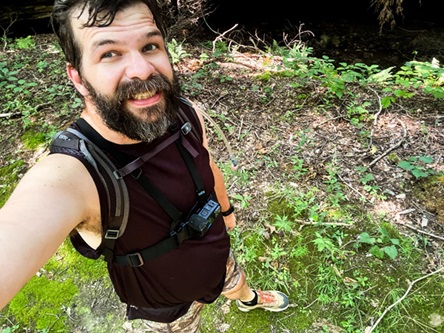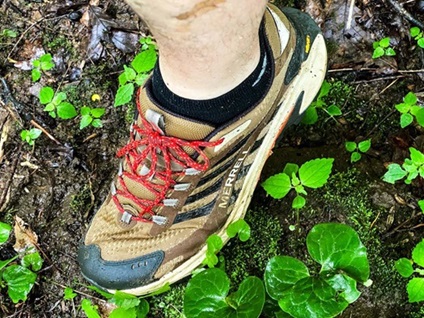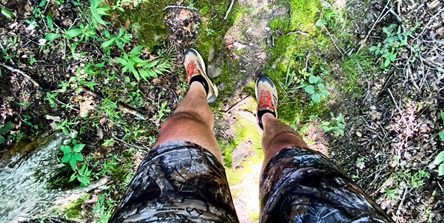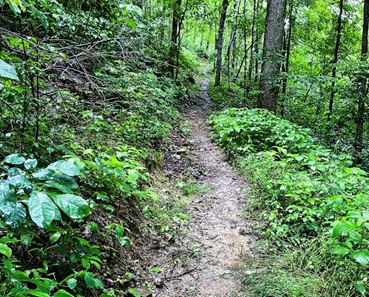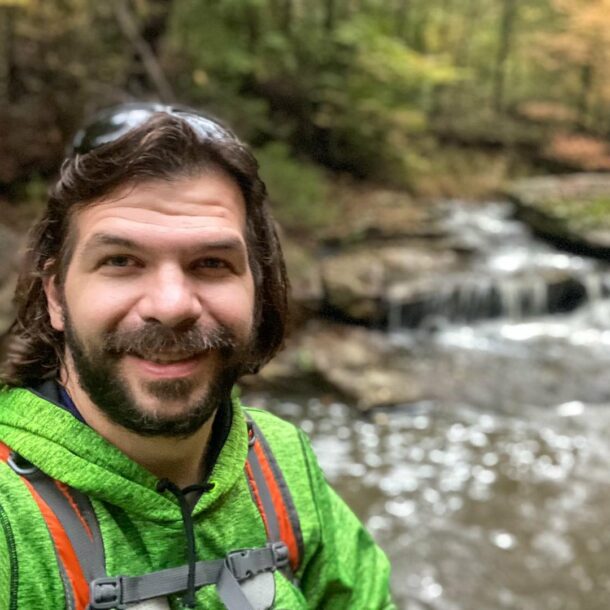How to Start Trail Running in the Shawnee National Forest
I recently wrote an article on another blog about why cycling is better than running, but little did I know that a few months later, I would be trail running.
I signed up for a half-marathon trail run. I wasn’t a runner before I signed up for it. However, once I started training, I realized I absolutely love trail running.
Obviously, being the Shawnee National Forest fanboy that I am, I’ve been running in the Shawnee for quite some time since I signed up for the half marathon.
I’ve learned a little bit about trail running, too. That’s why I’ve written this guide. Because I want to show you how to start trail running in the Shawnee National Forest, as well.
Trail Running versus Regular Running
Trail running is exactly what it sounds like – you’re running on the trail.
When you trail run, you run on hiking or mountain biking trails, or in many cases, in Southern Illinois, equestrian trails, as well. Regular running usually takes place on the road or indoors on a treadmill. You can practically run anywhere, but you may need to travel for trail running, depending on where you live in the region.
Trail running has its own disadvantages, just as regular running does.
Running on the trail can lead to slipping, tripping, and falling, which can hurt you. Running on pavement or concrete can often lead to injuries from the shock and impact of hard surfaces. You should definitely pay attention to your body when doing either type of running.
You’ll typically use different shoes and gear for the two types of running as well.
Trail running requires trail runner shoes, which are designed for rugged environments, whereas regular running just demands regular running shoes. You’ll often bring hiking gear with you on a trail run, too. Typically, you’ll wear the same types of clothing when doing either type of running.
Running on the trail isn’t for everyone, but neither is regular running. If trail running is for you, then I suggest continuing to read this guide.
Choosing Trail Running Shoes
Trail running often requires a specific type of running shoe designed for outdoor and rugged trail use.
Traction is really important when running on trails. There are mud, dirt, rocks, roots, and other obstacles that will be slick and steep, and you must be able to run across them without fear of losing your grip.
Protection is also important with trail runner shoes. You’ll want to ensure your toes and feet are protected from the elements or from being struck against a rock or other obstacle. This often means the shoe requires a sturdy material construction, a toe guard, and an ankle guard.
Stiffness is often a personal preference. Decide if you need a trail running shoe that is stiff or loose. It’s a good idea to break new shoes in on shorter trails to loosen them up before taking them on longer runs.
There are also different types of trail runner shoes. Light ones are for easier trails that have fewer obstacles. Rugged ones are for harder trails where traction is a must. You might also consider off-trail shoes if you’ll be running in a super rugged environment.
Several key features are worth noting. This may include rock plates, guards, different thicknesses of cushions, and the drop of the shoe. This will depend on your preferences. This is a good reason to visit a running shoe store and ask for professional help in finding the best trail running shoe.
Fit is really important. Your shoes need to fit you properly. You might just need a regular one, or you might require a wide one. You also want to consider the toe box to ensure maximum comfort.
Most trail running shoes are not waterproof. Expect to get your feet wet if you run through water. The last thing you want is a waterproof shoe that’s heavy or unable to breath, causing you to get blistered and who knows what else.
Insoles and running socks are great choices for proper running gear to take with you on the trail. You might need the extra padding an insole can provide. Specialized trail running socks will also help wick moisture from your feet, especially when you get them wet.
Gaiters are covers that go over the tops of your shoes to help keep debris out. As you run, you’ll kick up little sticks, rocks, dirt, and leaves, and it could get into your shoes and cause discomfort. Gaiters will help keep most of that out of your shoes.
Tie your shoes properly before running on the trail. You want to ensure everything is laced properly and tied correctly. The last thing you want to do is trip over your shoelaces while running in a rugged environment.
There are many different brands of trail running shoes available. You should try different ones on at local running and shoe stores to find your perfect pair of shoes. I wear the Merrell brand myself, but others have also suggested the Hoka and Altra brands.
Trail Running Clothing
While your shoes are your most important gear for running on trails, you also need to consider wearing the right clothing, too.
During the warmer months, your goal should be to wear moisture-wicking running clothes that are breathable and allow for optimal airflow. During the colder months, focus on layering up to ensure total comfort when you’re cold and as you warm up. You also want to make sure you wear the right running clothes for the elements you’ll be running in.
Bottoms: I typically wear a pair of half-tight shorts (compression shorts) because they help prevent chaffing and are made with breathable material. Wick moisture, and in my opinion, they are very comfortable. However, some folks prefer baggy shorts. It’s really based on your preferences. In the winter, I wear tights, whether they are insulated or not, based on the temperature. The brands of shorts and tights I typically opt for include REI, Janji, BOA, and CompressionZ.
Shirt: In warmer weather, I’ll wear either a short-sleeved or no-sleeved dry-fit shirt. I usually get them from Amazon and go for the cheaper ones. As long as they wick moisture. I prefer my shirts to be a little baggier. In the winter, I’ll usually wear a non-insulated compression shirt as my base layer, a long-sleeved running shirt over it, and a running hoodie.
Extras: I usually wear cycling socks as my running socks. They’re thin, compression-based, and wick moisture effectively. I use Bontrager brand cycling socks. I’ll use Alpaca wool socks from the My Comfy Socks brand during the winter months. I also wear a running beanie from Janji and gloves from Amazon.
Other: You may also want to pack sun sleeves for your arms and legs, a hat or visor, and extra layers for when it’s cold, depending on your needs. Rain gear may also be necessary if you plan to run in such conditions.
I won’t typically run in extremely cold weather where you need thicker jackets and a face covering. I’ll just hike in that weather for cardio and training.
Choosing Trail Running Gear
Trail running is similar to hiking in that you’ll want to pack the right kind of gear to ensure your run is safe and sound.
Pack: Your first gear item should be the backpack you plan to carry most of your stuff in. You don’t want anything super heavy, though. I suggest a hydration backpack with storage or a running vest with storage. I use an Osprey Hydration Pack.
Hydration: You’ll either want to carry a water bladder (I use a 3-liter water bladder in my hydration pack) or water bottles. It’s also a good idea to bring a small water filter with you, such as a Sawyer Mini. Having plenty of water is essential to your safety and well-being.
Nutrition: Bring food and snacks that are easy to eat and pack without requiring a specific temperature. I usually take trail bars, gels, chews, and hydration tablets with me on my trail runs.
Navigation: Make sure you can navigate the trails. Bring a map and compass (if you know how to use them), a GPS device, a Personal Locator Beacon (for safety), and a relevant app on your phone.
Electronics: Bring any electronics that you personally need. I wear a Garmin fitness watch to track my runs and record my health information. I also bring my cell phone with me and a GoPro Camera on a chest mount to record my runs for YouTube.
Lights: Bring a flashlight or a headlamp with you just in case you get lost or are there past daylight. Bring some extra batteries, too. I carry a little flashlight with me.
Sun Protection: Bring sun protection if you need it. This might include lip balm, sunscreen, a hat, and sunglasses.
First Aid: Bring small items that you might need just in case. I usually bring some lubricant in case I start to chafe, band aids, moleskin, diarrhea pills, ibuprofen, antihistamines, alcohol pads, sting wipes, and hand sanitizer.
Bug Protection: Bring some bug spray with you just in case you need it. Apply it before you run, but as you sweat, you may need to reapply it. Apply permethrin to your footwear, clothing, and gear (not your skin) to prevent ticks and other biting insects.
Money & Documents: Bring some cash and a credit card just in case you need it. Bring some identification and any relevant emergency medical information or contact lists you may want to pack with you.
Shelter: If you wish, you can pack this gear for just in case moments. I suggest an oversize rain poncho, which is great for shelter and to wear if it rains. Bring some waterproof matches with you in case you need to build a fire.
Poles: Some trail runners find it helpful to use trekking poles as they run. It helps stabilize them and retain balance. They’re also great for crossing creeks.
Weapon: You may wish to bring some type of weapon with you. This could be anything from a knife, pepper spray, or even a firearm. Please ensure that you maintain a valid FOID and a Concealed Carry card if you plan to bring a firearm. Illinois only recognizes its own FOID and CCW cards and does not recognize those from other states. You can be charged with a crime if you carry a firearm without an Illinois Firearm Owner’s Identification (FOID) card. I want to note that the Shawnee and Southern Illinois areas are generally very safe for all outdoor recreation users, aside from the occasional incident, like anywhere else in the world.
Ultralight Gear: Adding the gear above will increase the weight of your pack. Some trail runners prefer to be ultralightweight, meaning they carry as little as possible to save weight. Just ensure that you’re not sacrificing safety for weight.
The gear choices above will get you started for trail running, especially in the Shawnee National Forest.
Where to Start Trail Running
There are many great places in the Shawnee National Forest and Southern Illinois to start trail running.
Forest Service Roads & Trails: The Shawnee National Forest features over 400 miles of trails and Forest Service roads. Often, Forest Service Roads (FSRs) will provide a wider path if you prefer that; otherwise, there are many singletrack trails within the Shawnee to run. I prefer running on designated mountain biking trails as they’re technical and well-kept.
State Parks & Trails: State Parks (like Giant City, Ferne Clyffe, and Dixon Springs) and State Trails (Tunnel Hill State Trail) are great for beginner trail runners and those who desire more maintained trails.
Running Groups: There are many running groups in Southern Illinois. Most of them are unofficial, rather informal groups of friends that get together, but often welcome newcomers. Social media is typically where you can find most of these folks. I’ve created a Facebook Group called Southern Illinois Trail Running, which you can use to help find running groups and partners.
Apps & Maps: There are many great apps to help you find trails to run on. My favorite apps include Avenza, AllTrails, Gaia, TrailForks, and OnX Hunt. You can also purchase maps from the Forest Ranger Stations and Friends of the Shawnee National Forest.
Share the Trail: Consider the needs of other trail users. For example, horseback riders use many of the trails in the Shawnee National Forest. All types of users MUST yield to horseback riders. Yield and talk to them in a normal voice so that the horses or mules know that you’re not a threat. Mountain bikers must yield to equestrians, hikers, and trail runners. When going uphill, yield to those going downhill, as it’s harder for them to stop. When using an FSR, do remember that many of these roads allow motor vehicles, so please watch out for them. Remember to share the trail and be nice to one another.
If you need more ideas on where to go trail running, feel free to comment on this post, and I’d be happy to provide some suggestions.
Techniques to Improve Your Trail Runs
You should utilize proven techniques to train yourself to become a better trail runner and prevent injury.
Try to run or jog in a short stride while keeping your feet under you at all times while trail running on uneven terrain.
Constantly scan the trail ahead to look for potential hazards and obstacles that may appear in your path.
As you run or even fast hike, swing your arms out to help stabilize your balance on uneven and rugged terrain.
When going uphill, try to shorten your stride even more by taking smaller and more frequent steps to balance yourself on the trail and help yourself get up the hill.
When running uphill, do your best to avoid leaning forward, as it can reduce your breathing as you try to make it up the hill.
When running downhill, ensure that you don’t lean back, as this can increase your chances of falling and becoming injured in the process.
As you run on flats, uphill, or downhill, it’s ideal to try to keep your back straight so that you have a safe and good posture during your run.
As you approach steeper or rugged parts of the trail, slow down and hike through these sections to reduce the risk of an accident.
You need to focus on your form as a trail runner, rather than focusing on speed, especially as a beginner at trail running.
Trail running isn’t about continuous running; it’s better to do short bursts of running as you get better and more accustomed to it.
Implementing the trail running tactics above will help develop your technique as a trail runner and improve your performance each time you go out.
Trail Running Safety
Trail running safety is essential, and it should always take priority over everything else.
Try to get to know the trail you will be running on, especially if it is remote or off the beaten path.
Always keep track of weather and trail conditions before and during (if possible) your trail running session.
Try to carry enough food and water with you to last for a few days if you were to get lost and had to ration it out.
Always tell someone where you will be running before you go trail running, just in case you don’t make it back.
You need to take breaks when you start to feel tired, especially on days that are extremely hot and humid.
Be sure to take mental notes of landmarks and features along the trail to remember later, just in case you start to get lost.
Try to understand local hazards, such as venomous snakes, harmful plants, and hazardous wildlife, in the area where you will be running.
You should always prioritize safety and remember that the best way to stay safe is to use common sense and always be mindful of your surroundings.
Trail Running Nutrition
It’s important to eat and drink right before, during, and after you go trail running so that you can perform well and remain healthy.
Before you go trail running, try to eat some digestible carbs. Avoid foods that are high in fat and fiber. This will help keep your stomach in good health for your run. Drink plenty of water to start feeling hydrated.
During your trail run, you’ll want to eat something every 30 minutes, especially when it’s hot a humid. I recommend eating a bite of your trail bar, a handful of trail mix, some chews, a gel, and similar snacks. Then wash it down with a few swigs of your hydration. This will keep you hydrated and fueled during your run.
After you get done trail running, you’ll want to eat something with protein in it to help you build important muscles and stamina post-workout. Be sure to also drink plenty of fluids to rehydrate yourself and your muscles.
Don’t skip out on eating and drinking right; otherwise, all your hard work will be for nothing, and you might find yourself getting hurt in the process.
Trail Run Events and Racing
There are many different types of trail running distances, events, and races to participate in.
Ultras are runs and races that are longer than marathon lengths, which are typically 26.2 miles in length. A 50K and a 100K are excellent examples of ultra-trail running events.
Most local fun runs and races typically include distances of 5K (3.1 miles), 10K (6.2 miles), half marathon (13.1 miles), and full marathon (26.2 miles). You can usually find one every weekend around Southern Illinois.
As a beginner, you should compete against yourself while you’re getting into trail running. It’s easy to get overwhelmed and burn out if competing against others who are better at it than you. Compete against your own scores and strive to improve.
An FKT is an abbreviation for Fastest Known Time. Many trails have FKT champions. Lindsey Roberts is a local runner, cyclist, and triathlete who is known for beating many local FKTs. You just have to be the fastest on the route to beat them, and FKTs are usually sanctioned in some way with an association to an FKT website.
There are many Local Trail Running Events to explore as you get better and better at trail running. I recommend checking out Shawnee Hills Trail Races, The Last Boy Scout, Tunnel Hill 50/100, Run for Heroes, and Red Cedar Race if you want to try competitive trail running.
Now, Over to You!
Now that you’ve learned how to start trail running in the Shawnee National Forest and Southern Illinois, it’s up to you whether or not to make the leap and start doing it.
On a final note, it’s okay to be bad at trail running when you first start out. I was. I’m getting better and better each time I get out there, and I’m loving it more and more each time, as well.
Let me know in the comments where you like to trail run and what your favorite part about trail running is. I’d love to hear from you!
If you’ve enjoyed this post and would like to support me in publishing it, please consider leaving a small one-time donation or becoming a monthly supporter on my Patreon page.
Join my free hiking and backpacking forum at The Hiking Forum. There are no ads, and even a section is dedicated to discussing trail running. This forum is for everyone, no matter where you’re hiking.
Subscribe to my free monthly newsletter for more hiking tips, resources, and upcoming local events.
And until next time, I’ll see you on the trail!
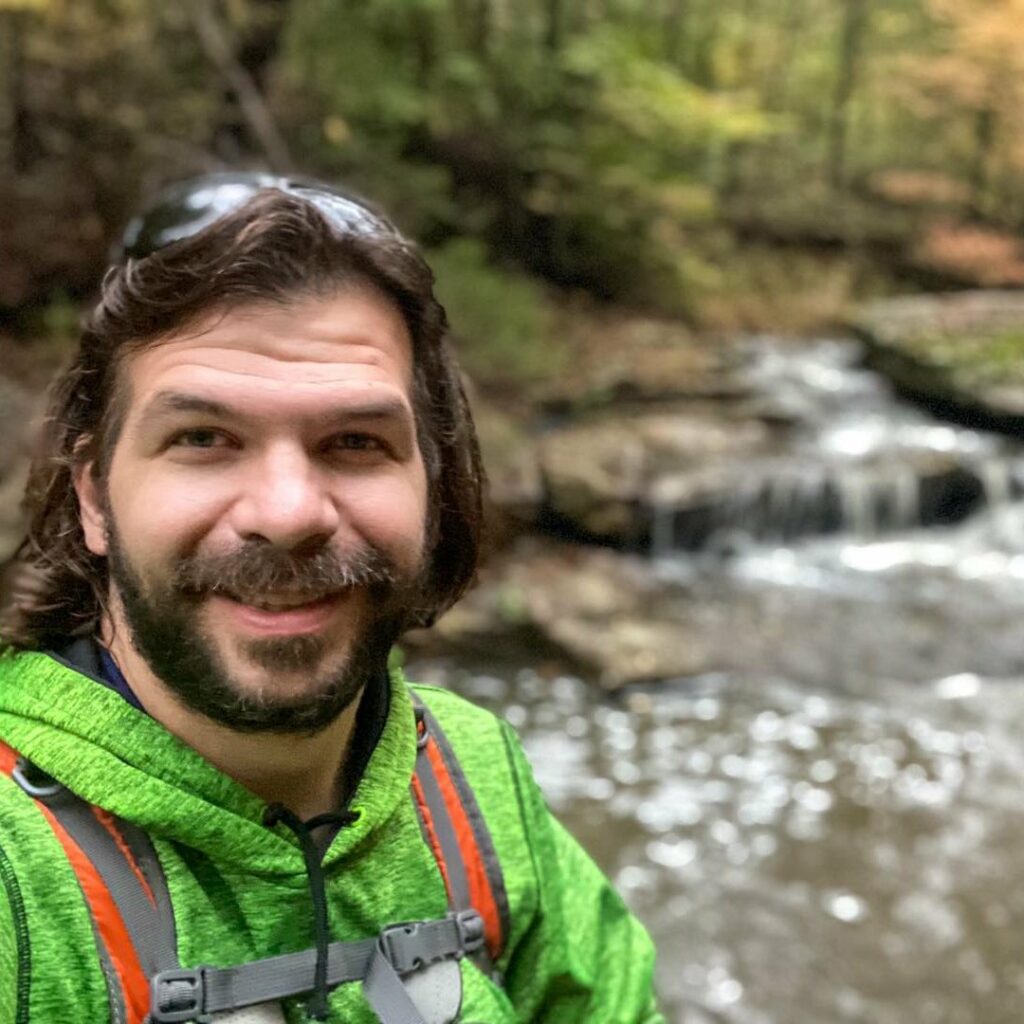
Shawn Gossman
Founder, Hiking with Shawn
Howdy folks! My name is Shawn Gossman and I founded Hiking with Shawn. I’m an avid hiker, cyclist and outdoorsman here in the Shawnee National Forest. I was born and raised in Southern Illinois and never want to leave. Click here to learn more about Shawn Gossman

